Designing and installing a heating system yourself is a difficult task. To solve it, it is necessary to first solve a number of important issues - to choose the best option for the energy carrier, to decide on the layout of pipes and radiators. That is why the practical implementation of a cottage heating system with your own hands is important: schemes, projects.
- Cottage heating schemes - piping layout
- Single pipe cottage system
- Two-pipe heating scheme of a cottage
- Collector heat supply of the cottage
- Gas heating of the cottage
- Choosing a boiler to complete the heating system of a cottage
- Additional heating equipment for a cottage
- Heating a cottage without gas - possible options
- Stove heat supply of the cottage
- Heating of the PLEN cottage
Cottage heating schemes - piping layout
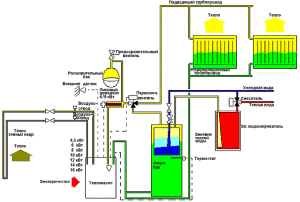
In this article, only do-it-yourself water heating of a cottage will be considered, as one of the most optimal and economical. Along with it, it is possible to equip additional heat supply systems - geothermal and PLEN. Thanks to them, operating costs will be reduced and the level of comfort of living in a cottage will increase.
Any project for heating a cottage begins with choosing a pipe layout. The rate of heating of the radiators, the maintainability of the system and the possibility of expansion for heat supply of additional rooms or household buildings will depend on it.
Single pipe cottage system
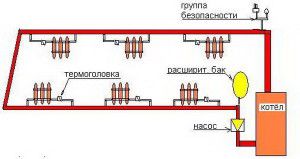
Installation of a one-pipe circuit is one of the easiest ways to make turnkey heating of a cottage. Its design principle is to install only one line to which radiators are connected in series.
It requires powerful gas boilers to heat the cottage, since as hot water passes through the radiators, a significant decrease in its temperature will be observed. The one-pipe scheme is characterized by ease of installation and low cost of purchasing materials. However, at present, this scheme of the cottage heating system is practically not used for the following reasons:
- Problems in performing hydraulic and thermal calculations. It is difficult to predict the possible pressure in the cottage heating system, since the characteristics of the coolant change as it cools;
- Difficulty adjusting the degree of heating of the batteries. Restricting the flow of coolant into one of them will change the thermal mode of operation of the entire system;
- Limited number of plug-in batteries.
That is why this cottage heating scheme is used for buildings whose area does not exceed 50 m². To be able to dismantle or repair the radiators, a bypass must be installed on each of them.
Two-pipe heating scheme of a cottage
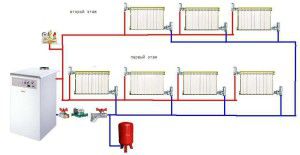
To improve the operating parameters, it is recommended to install a two-pipe heating system for the cottage. It differs from the one discussed above by the presence of an additional line - a return pipe. In this case, the radiators are connected in parallel.
If you plan to heat the cottage with gas, you need to take care of reducing its consumption. This can be done in several ways. But the most optimal is the installation of a two-pipe heating system for the cottage. For independent design and selection of materials for installation according to this scheme, it is necessary to take into account the following points:
- Mandatory calculation of the diameter of pipes to minimize hydraulic losses and prevent pressure drop in the heating system of the cottage;
- Consumption of material in comparison with a single-pipe will increase at least twice. This will affect the overall budget for creating a cottage heating project;
- Mandatory installation of thermostats on radiators. With their help, you can change the heating of devices without affecting the general parameters of the system.
Design flexibility is characteristic of this cottage heating system scheme. If necessary, you can install additional risers (horizontal or vertical) to connect new radiators or heat supply to another room or building.
To improve the appearance of rooms, you can choose a heating scheme for a cottage with hidden installation of pipes. However, it is necessary to provide access to key system nodes.
Collector heat supply of the cottage
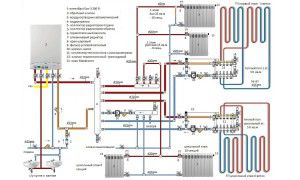
How to properly make heating in a cottage if its area is equal to or exceeds 200 m². Even the installation of a two-pipe system in this case will be impractical. To resolve this issue, it is best to apply collector piping.
Currently, this is one of the most difficult ways to organize heating a cottage with your own hands. For uniform distribution of the coolant over a large area of the building, a multi-beam piping scheme is used. Immediately after the boiler, the main and return collectors are installed, to which several independent highways are connected. Unlike a two-pipe heating system of a cottage, a collector one provides for the possibility of regulating the operation of heat supply for each individual circuit. For this, control devices are installed - thermostats and flow meters.
The features of the collector heating of a cottage, made by hand, include:
- Uniform distribution of heat along all circuits, regardless of their distance;
- Possibility of using pipes of small diameter - up to 20 mm. This is due to the small length of each node of the system;
- Increased pipe consumption. In order to correctly make collector heating in a cottage, it is necessary to draw up a diagram of the installation of pipelines in advance. They can be wall or floor mounted;
- Mandatory pump installation for each circuit. This is due to the high hydraulic resistance in the manifold. It can impede the circulation of the coolant.
When choosing a ready-made project for heating a cottage or when compiling it yourself, you need to take into account the heat losses of the building. The design capacity of the entire system will depend on them.
For two and three-storey cottages with a large area, a heat supply system diagram with several distribution manifolds is best suited.
Gas heating of the cottage
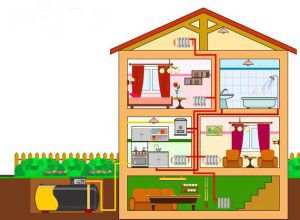
One of the best options for creating a scheme for maintaining a comfortable temperature in a country house is heating the cottage with gas. To do this, you need to connect to a central distribution line or equip a storage space for cylinders. An alternative to such an organization is the installation of a gas tank - a special gas storage facility.
But at the first stage, it is necessary to choose the right boiler for heating the cottage. It must provide optimal performance of the entire system, be reliable and functional.
Choosing a boiler to complete the heating system of a cottage
The main parameter of any heating survey is its rated power. The same applies to cottage heating boilers. To calculate this parameter, it is best to use special software packages. It is necessary to first calculate the heat losses of the building.
After determining the rated power of the boiler, you should select its model.The main parameters are its functional and performance characteristics:
- Installation method - floor or wall. If a heating scheme for a small cottage is chosen, you can choose wall models. For houses with a large area, it is necessary to install powerful gas boilers. Most of them have a floor wiring diagram;
- The presence of a second circuit heating water for organizing hot water supply;
- Boiler control and safety devices... They will ensure optimal pressure in the heating system of the cottage. This parameter for a closed system with forced circulation varies from 3 to 6 atm.
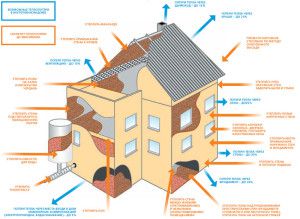
An important point is the preliminary calculation of the gas consumption for heating the cottage. This parameter is indicated by the manufacturer in the passport. For appliances with a power of 24 kW, the average consumption is 1.12 m³ per hour. Accordingly, in order to obtain the preliminary gas consumption for heating a cottage, this value must be multiplied first by 24, and then by the number of days in the heating season.
The installation of gas boilers for heating the cottage must be carried out by companies licensed to carry out this type of work. Otherwise, representatives of the management company will have the right to disconnect the house from the central highway.
Additional heating equipment for a cottage
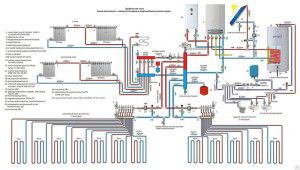
Professional planning of heating in a cottage involves the selection of all components of the system according to pre-calculated parameters. Otherwise, even with the installation of a modern and economical gas boiler for heating the cottage, the efficiency of the entire system will be unsatisfactory.
It should be borne in mind that when purchasing a turnkey cottage heating project, it will be problematic to change any characteristics of the system components. Therefore, you need to familiarize yourself with the content of the technical documentation in advance. To do this, you need to know the basic technical properties of the heating elements of the cottage:
- Radiators... With their help, heat energy is transferred from hot water to the room. An important parameter is the specific power - watts. This total value of the radiators installed in the room must correspond to the calculated one for the room;
- Pipelines... Their diameter and material of manufacture are influenced by the thermal mode of heating. Effective heating of a cottage with a gas boiler implies a low-temperature operating mode - 55/40 or 65/50. This will reduce the gas consumption for heating the cottage. For such schemes, polymer pipes can be used;
- Security group... These include an expansion tank, air vents and drain valves. It is mandatory to provide for the installation of valves on critical sections of the line - forks, when connecting radiators.
In practice, the complete set of the heating system largely depends on the characteristics of the building - its area, the degree of thermal insulation, the selected heating scheme. The parameters of each device must be calculated in advance.
For gas heating of a cottage, it is necessary to install a reliable system for removing carbon monoxide - a chimney. For this, it is recommended to use sandwich chimneys.
Heating a cottage without gas - possible options

But what if there is no possibility of organizing gas heating for the cottage? Installing solid fuel boilers is not always advisable. Therefore, owners of suburban real estate are considering alternative options for heating a cottage without gas.
The easiest way to maintain a comfortable temperature in cottage rooms is to install an electric heating boiler. It can be both the main source of thermal energy and auxiliary.However, it will be characterized by high energy consumption costs. This will significantly affect the family budget of those living in a large cottage.
Therefore, we propose to consider other alternative methods of heating a cottage without gas. Each of them has a specific service and configuration and is not always suitable for organizing heat supply for a particular residential building.
Together with the installation of an electric boiler for heating a cottage, it is recommended to install a heat accumulator. With its help, you can switch to the night mode of operation of the equipment - at this time there is a reduced tariff for heating.
Stove heat supply of the cottage
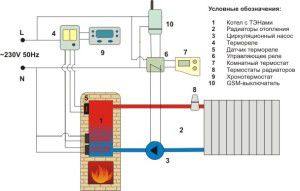
Upon initial analysis, it can be concluded that stove heating of cottages is ineffective. However, it is necessary to take into account the peculiarities of the operation and characteristics of a country house - its total volume, the degree of thermal insulation and the frequency of residence.
For buildings small in area and in the absence of a gas main, combined heat supply can be made. Considering that stove heating is installed in many old cottages, a small modernization is made to improve its characteristics:
- Electric boiler installation... It must have a coolant temperature sensor and a heating element shutdown function when optimal water heating is achieved. A heat exchanger is mounted in the furnace and connected to a common water heating system. As a result, the coolant is heated from it, and the electric boiler only maintains the desired temperature level;
- Air heating... A steel air pocket is installed around the furnace firebox, which is isolated from the combustion chamber. Air lines are connected to this structure, which deliver hot air to the premises of the cottage. To increase the air exchange rate, it is possible to install fans.
You can also opt for traditional stove heating at home. Then you should make a system of air ducts - chimneys. With their help, the wall next to which the oven is installed will be heated. Stove heating means annual chimney cleaning. A large amount of soot inside the pipes will impair traction performance.
Heating of the PLEN cottage
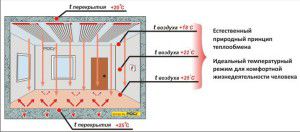
If it is necessary to heat the cottage without gas equipment and at the same time maintain the maximum useful volume in the premises, it is best to install film ceiling systems.
The main heating element in heating PLEN is a thin film, on the surface of which carbon strips are applied. When a current passes through them, the temperature rises and, as a consequence, the generation of IR waves. As they spread, they heat not the air, but the objects that have fallen into the area of the system.
When choosing a cottage film heating, the following factors should be taken into account:
- Obligatory good thermal insulation at home. The average power of foil heating is 180 W / m². With high heat losses through the outer walls, the system simply cannot compensate for them;
- The coverage area of the PLEN should be at least 75% of the entire ceiling in the room.
Also, in addition to heating elements, it is necessary to install systems for monitoring the operation of the film. To do this, it is best to use special thermostats and programmers connected to temperature sensors.
For the reliability of the heating of the cottage, it is recommended to purchase a ready-made project or order it for a specific building. In the latter case, engineers will take into account all the nuances - the characteristics of the house, the climate in the region.
Alternatively, it is fashionable to consider an example of organizing heating a cottage using a water-heated floor system:







